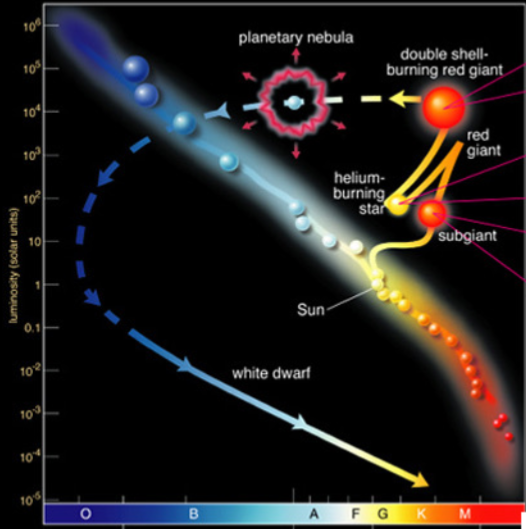Midterm 2 AST010G Study Guide
1/93
There's no tags or description
Looks like no tags are added yet.
Name | Mastery | Learn | Test | Matching | Spaced |
|---|
No study sessions yet.
94 Terms
Suppose the angular separation of two stars is smaller than the angular resolution of your eyes. How will the stars appear to your eyes?
a) You will not be able to see these two stars at all.
b) The two stars will look like a single point of light
c) The two stars will appear to be touching, looking rather like a small dumbbell
d) You will see two distinct stars
e) You will see only the larger of the two stars, not the smaller one.
b
What causes stars to twinkle?
a) It is intrinsic to the stars -- their brightness varies as they expand and contract.
b) variations in the absorption of the atmosphere.
c) variable absorption by interstellar gas along the line of sight to the star
d) bending of light rays by turbulent layers in the atmosphere.
e) the inability of the human eye to see faint objects
d
What is the purpose of adaptive optics?
a) to improve the angular resolution of telescopes in space
b) to eliminate the distorting effects of atmospheric turbulence for telescopes on the ground
c) to increase the collecting area of telescopes on the ground
d) to increase the magnification of telescopes on the ground
e) to allow several small telescopes to work together like a single larger telescope
b
Which of the following is NOT a good reason to place observatories on remote mountain tops?
a) to reduce light pollution
b) to reduce light absorption
c) to be able to observe at radio wavelengths
d) to be able to observe at infrared wavelengths
c
What is the aperture of a telescope?
The aperture is the diameter of the first lens or mirror that the light encounters in a telescope
What is the difference between a refracting telescope and a reflecting telescope?
A refracting telescope uses lenses, while a reflecting telescope uses mirrors (refactor left, reflector right)
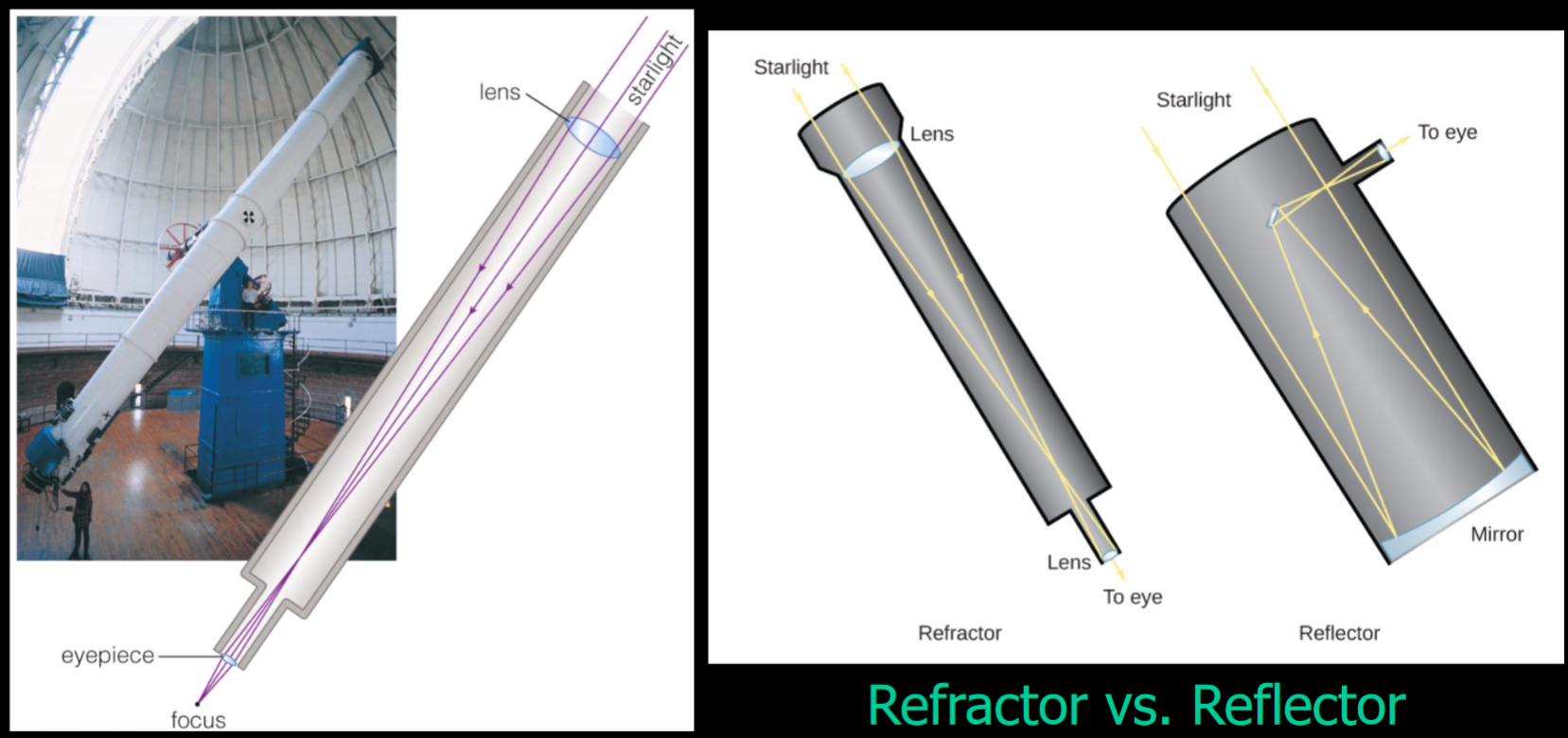
What is prime focus for a reflecting telescope?
One reflection telescope
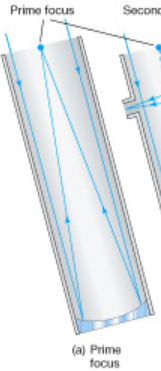
What is cassegrain focus for a reflecting telescope?
Two reflections, focus out of a hole in the primary mirror
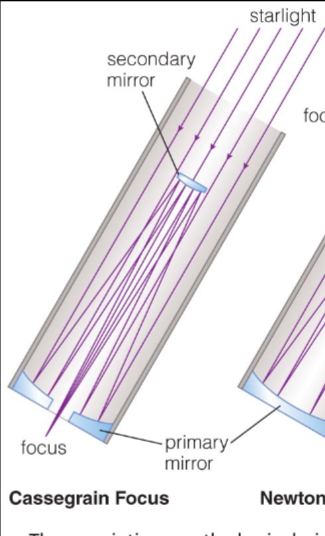
What is Newtonian focus for a reflecting telescope?
Two reflections, focus out of a hole near secondary mirror
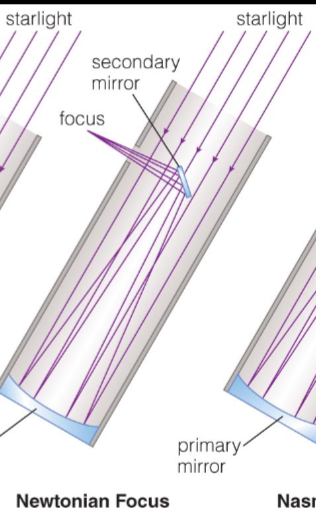
What is Nasmyth/Coudé focus for a reflecting telescope?
Three reflections, focus out of a hole near tertiary mirror
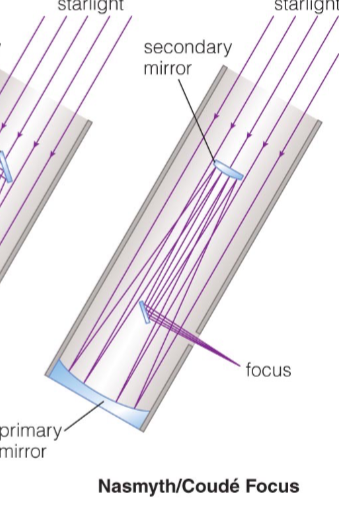
What are the two main reasons have a bigger telescope is better
A bigger telescope means a better angular resolution ( higher diffraction limit) and more light gathering power ( larger “light buckets”
What is the diffraction limit and what does it depend on?
The diffraction limit of a telescope (or your eye) is set by its
diameter (size), and its definition is the best angular separation your telescope can detect.
θlimit ~ λ/D. λ is a constant (wavelength of light), and d is the diameter so the larger the diameter the smaller the diffraction limit
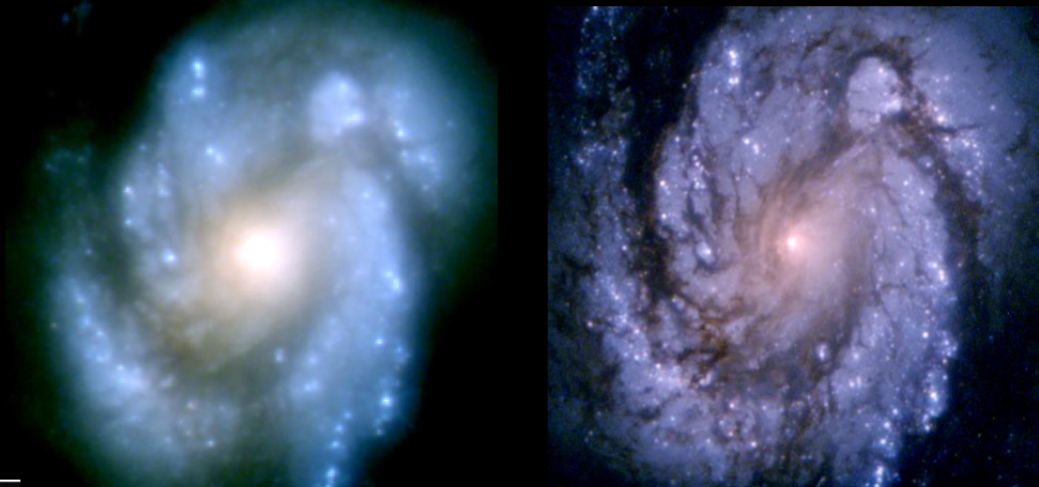
What conditions on earth are best for a telescope and why?
telescopes are usually on remote mountaintops
higher above the atmosphere which allows for better resolution
dry air, better weather
being in a dark less light polluted area is preferred
How does the atmosphere affect light around it
Photos passing through the earths atmosphere are deflected lightly, so light through a telescope appears to “move”
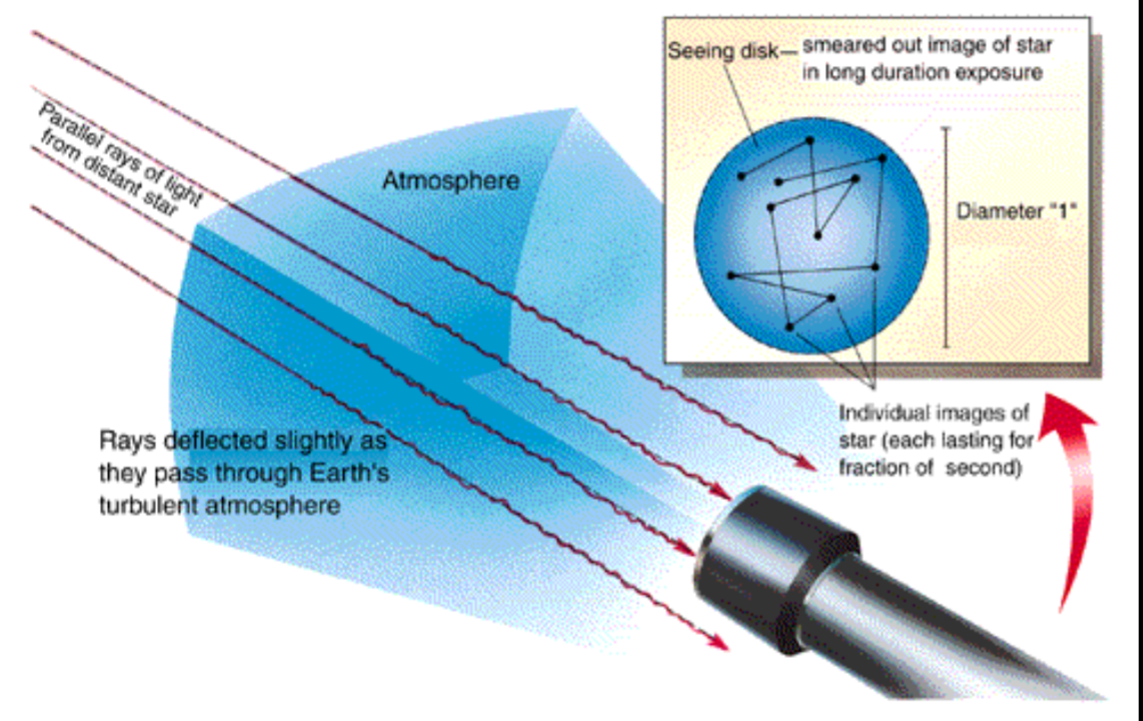
What is seeing?
The diameter of how much a star moves in a seeing disk (due to atmospheric turbulence), larger is worse smaller is better
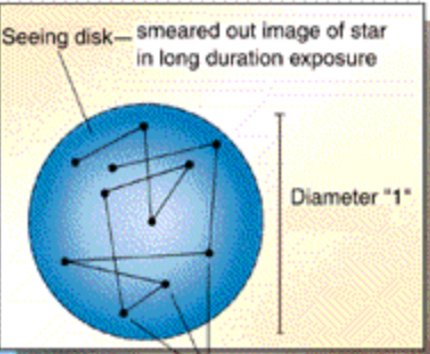
What are some of the techniques to avoid atmospheric turbulence
putting the telescope in space
adaptive optics
interferometry
What are some pros and cons for putting a telescope into space?
pros: the telescope is above the atmosphere, there is no weather to worry about
con: it is very expensive
What is adaptive optics?
Correct for atmospheric distortions in real time by feeding
information from a bright star to a deformable mirror, works for optical and Infrared.
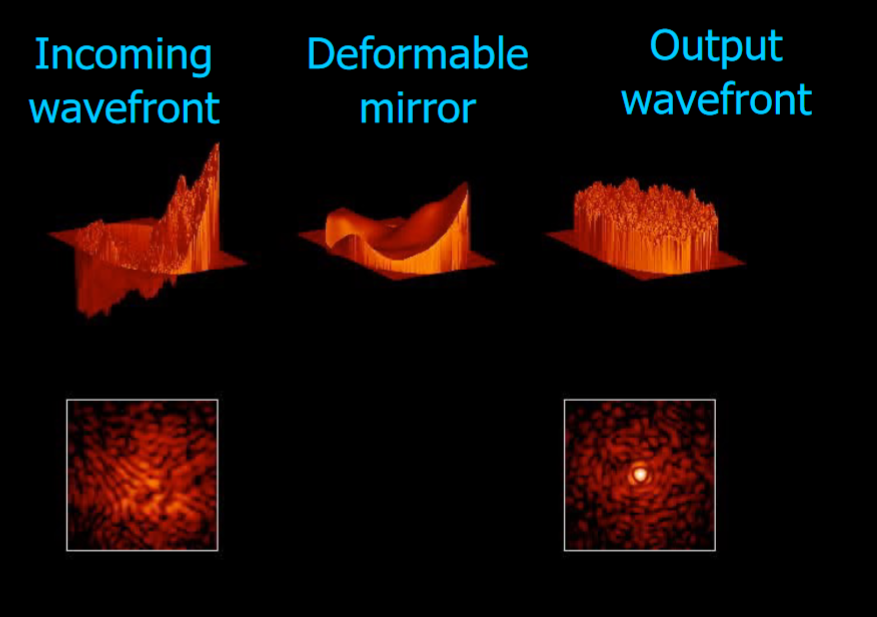
What is interferometry? (draw out what it looks like for your own practice)
Using multiple telescopes to improve your
angular resolution (at radio wavelengths)

What is Hydro static Equilibrium?
The balance between Gravity pushing in and thermal pressure pushing out for a star, when they are in equilibrium the star does not expand or contract. Basically gravity vs pressure
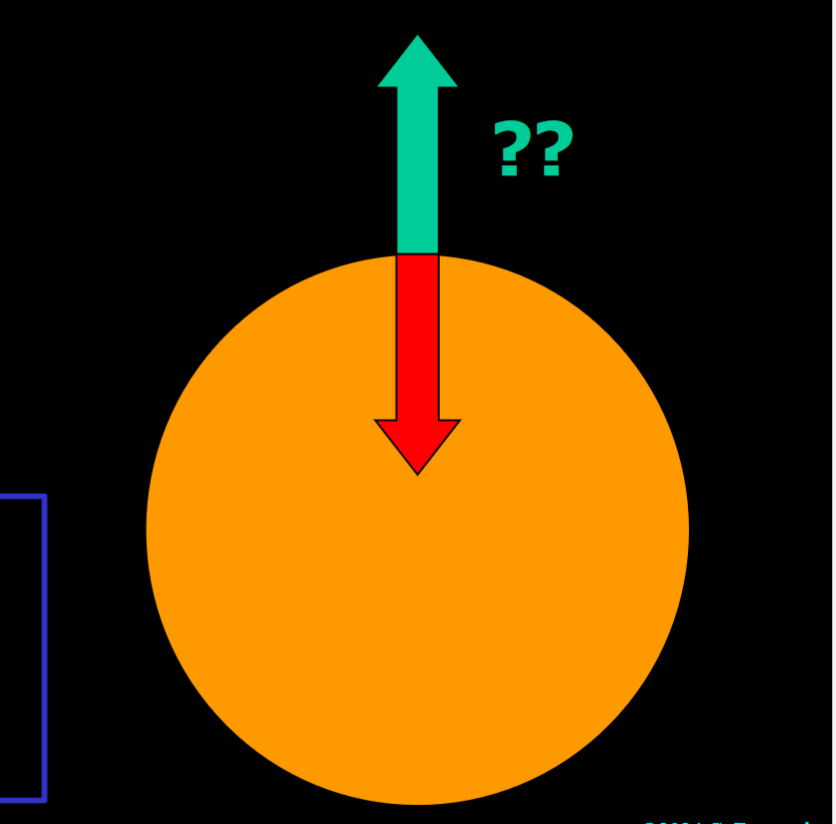
The most important function of an astronomical telescope is to:
a) magnify (enlarge) celestial objects so we can see them clearly
b) pierce through the clouds so a cloudy night is not wasted
c) collect as much light as possible and bring it to a focus
d) bring distant objects closer by pulling on the light
e) enhance the violet colors of an object, which our eyes have trouble seeing
c
To overcome the problems that blur images and don't provide the best resolution from Earth, astronomers have started using flexible mirrors that change shape many times each second. This technique is called:
a) adaptive optics
b) peer review
c) focal length adjustment
d) light pollution
e) lowering resolution
a
At the largest and most modern astronomical observatories on Earth today, which of the following typically happens to the image formed by the telescope?
a) it is reflected by a special arrangement of mirrors back into the beam and up into the sky
b) it is recorded using an electronic detector called a CCD for later analysis
c) it is viewed by a group of graduate students who then make a sketch of it to have a permanent record
d) it is sent to the FBI so they can check for evidence of Russian hacking
e) it is recorded on a piece of black & white film, which is then developed in a bath of chemicals
b
When they build big new (visible-light) telescopes, astronomers want to put them in places where they will get the best views of the sky. Which of the following is not an important part of how astronomers select places for new telescopes?
a) the place must be near a university or college
b) the sky above the place must be dark (no light pollution)
c) the place must be dry (not too much water vapor in the air)
d) the place must have clear weather on as many nights as possible
e) the air at the place must be quiet, not turbulent
a
Radio telescopes of modest size can't make out as much detail (have a lower resolution) than visible light telescopes. How do astronomers overcome this limitation?
a) this problem can't be solved; radio telescopes will always show poor detail
b) we have launched a small radio telescope satellite into orbit, which (being above the atmosphere) can make out much more detail than any visible light telescope
c) the same engineers responsible for the shape of the mirror for the Hubble Space Telescope are working on this problem; stay tuned
d) we can connect several radio telescopes some distance apart together electronically to give us the resolution of a larger telescope
e) they have built a radio telescope in the desert that completely covers 1000 square miles
d
The diagrams below show three arrangements for how light in a telescope can reach the observer.
Labels include: Reflecting, Refracting, Prime focus, Newtonian focus, Dispersing, Refracting, Cassegrain focus

What 2 Elements make up the majority of the sun?
Hydrogen and Helium
What percentage of the Sun's mass is made up of metals?
2%
What is the core of the sun?
The core of the sun is the center most region of the sun, extending from the center to around radius 200,000 km. It is the region where hydrogen to helium fusion occurs. The density in this region is really high compared to the others
What is the radiation zone of the sun?
The radiation zone is just outside the core of the sun. Here, photons of light carry the energy created through nuclear fusion reactions in the Sun's core toward the surface as thermal radiation
What is the convection zone of the sun?
The convection zone is just outside the radiation zone and the photo sphere; it is where hot plasma rises from the deeper layers, cools as it reaches the surface, and then sinks back down, creating a continuous cycle of convective currents (think of circular currents)
What are parts of the solar interior?
Core, Radiation zone, convection zone
What is the photosphere of the Sun?
The photosphere is the “surface” of the sun, it is where the sun transitions from opaque to transparent. Photons leave the solar interior.
What is the Chromosphere of the Sun?
a relatively thin region just outside the photosphere
What is the Transition Region of the Sun?
a very thing region outside of the chromosphere where the temperature jumps dramatically
What is the Corona of the Sun?
a low density but very hot region outside of the transition region of the sun; extends past the earth
What are the zones of the Solar Atmosphere?
Photosphere, Chromosphere, Transition region, and Corona
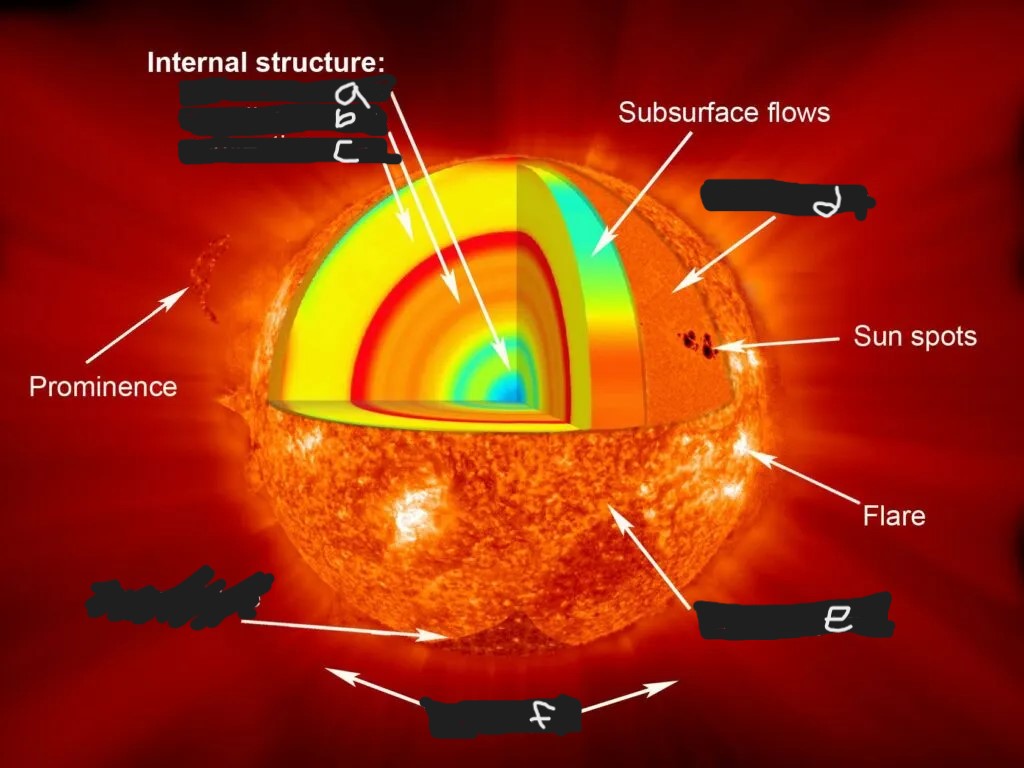
Label the zones a-f
a) core
b) radiative zone
c) convection zone
d) photosphere
e) chromosphere
f) corona
What are granules? How are they related to the way energy is transported within the sun?
small, bright areas visible on the Sun's surface (photosphere) that represent the tops of rising columns of hot plasma from the layer below (think of water boiling), called the convective zone; these rising columns of plasma indicate the movement of energy through convection, which is the primary way energy is transported from the Sun's core to its surface
What is the approximate temperature of the core of the Sun?
10 million K
What is the approximate temperature of the photosphere of the Sun?
6000 K
Why do sunspots appear dark?
They are cooler regions of the photosphere
How big are sunspots on average compared to the earth?
a) 10 earths
b) 100 earths
c) 1 earth
d) 0.1 earths
e) 0.01 earths
c
The number of sunspots changes on a roughly _ yr cycle
a) 23
b) 11
c) 5
d) 500
e) they do not change, remains around the same
b
What is the temperature of the chromosphere?
6000-20,000 C
What is the temperature of the corona?
Around 1 million C, notable that it is much hotter than the layers underneath
What is nuclear fusion in Stars?
As a star is hotter during the center, nuclei get faster. At high speeds, nuclei come close enough for the strong nuclear force to bind them together (forming a single heavier nucleus)
How is nuclear fusion related to stars?
Stars generate energy in the center through nuclear fusion
What is the proton-proton chain? Describe the start and the end result.
4 Hydrogen nuclei (protons) combine to form a single helium nucleus, where a lot of the mass is lost.
How is E = mc² related to nuclear fusion?
E = mc² is Energy = Mass * speed of light squared, basically that through nuclear fusion 4 protons (hydrogen) become one Helium nucleus, so the mass in this process that is lost become energy
Why are neutrinos important as a diagnostic of the sun's fusion reaction?
Neutrinos are produced directly within the Sun’s core during the nuclear fusion process, allowing them to escape and reach earth carrying information about the conditions and reactions happening in the star. We can then study the flux and energy spectrum of neutrinos to gain insight into the temperature, density and composition of the suns core.
What is strong force in nuclear fusion?
Strong force is a force that binds nuclei together if they are close enough (happens in high density and temperature environment due to nuclei getting faster) this happens in nuclear fusion when 4 hydrogen nuclei bind together to become 1 Helium
How does temperature and pressure affect nuclear fusion?
Higher density and temperature allows nuclei to interact with each other, leading to nuclear fusion
What is the difference between nuclear fusion and nuclear fission
Nuclear fusion is what happens in stars its the conversion of Hydrogen into Helium and Energy, nuclear fission is radioactive and is used in atomic power, requires complex nuclei.
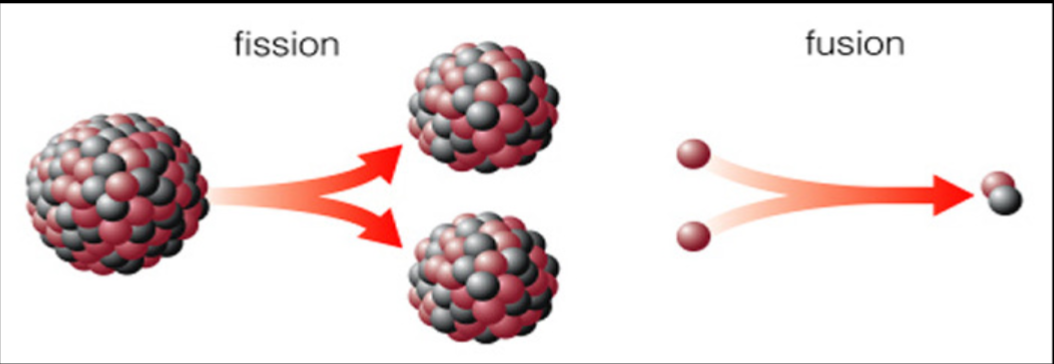
What is Luminosity and what does it depend on
It is the energy/light output of an object at a given time.
L = 4pi r²* F (r = radius of star, and F is flux)
How do we find the luminosity of a star?
To find the luminosity of a star, we need the flux (apparent brightness) and the distance of the star from us. Flux we measure through a camera, but distance we measure using parallax.
How do we find the Surface Temperature of a star? (2 ways)
You can get a estimate of a stars surface temperature from its color (red = cold, blue = hot)
By taking the spectra of a star and looking at its absorption lines, we can classify stars (OBAFGKM) and find their temperatures from their class
Lets say Star 1 has a spectral sequence of O, Star 2 is A, Star 3 is K, and Star 4 is B, which do you think would have the highest surface temperature
Star 1
Why can we use Spectral Lines to determine surface temperatures?
Absorption lines happen when an electron moves from one state to a higher state. Electrons always want to be in energy level 1 (ground state) collisions help them to get to level 2. The energy of typical collisions depends on the speed of the atoms. The speed depends on the temperature. So the “line strength” depends on the surface temperature

How do we find the Surface Brightness of a star?
We find the Surface brightness (flux) from the surface temperature of the star, using that F = σ T^4 (where σ is a constant)
How do we find the radius of a star?
We find the radius of a star from the surface brightness and luminosity, using the fact that
Luminosity = Surface area x Surface Brightness
L = 4pi r² * F, and move the equation around such that
r = sqrt( L/4 pi F)
How do we find the mass of a star? (individually, not a system)
By measuring a stars surface temperature and luminosity, and if it is on the main sequence of the HR diagram (90% of the time) you can find its mass.
The Sun's photosphere is
a) the hottest region of the Sun
b) the first region you would come to when leaving the core
c) the outermost layers of the Sun's atmosphere
d) the central region where the energy of the Sun originates
e) the part of the Sun from which the light comes that we see when we look at the Sun with our eyes
e
Sunspots are darker than the regions of the Sun around them because
a) they consist of different elements than the rest of the Sun
b) they are cooler than the material around them (although still very hot compared to Earth temperatures)
c) they are located in the corona and not on the photosphere
d) they are the shadows of the planets and asteroids seen on the bright surface of the Sun
e) they move much faster around the Sun than other material and thus heat up
b
In the formula E=mc2, the letter c stands for
a) the speed of sound
b) the speed of light
c) the amount of energy contained in one hydrogen nucleus
d) the energy of a neutrino emerging from the Sun
e) the speed of an electron around the nucleus
b
The antimatter version of an electron is called a
a) positron
b) proton
c) antitron
d) gammatron
e) neutrino
a
If the "fuel" for nuclear fusion is nuclei of hydrogen, and the Earth's oceans are filled with hydrogen atoms in water all being jostled together, why isn't there a lot of fusion happening in our oceans?
a) on Earth, only hydrogen that is in deep mines under the Earth is far enough underground for fusion
b) for hydrogen nuclei to fuse, they must get very close to each other, which the nuclei in the oceans cannot do
c) for hydrogen to fuse, the nuclei must first join together in long chains of atoms
d) the hydrogen in our oceans is the wrong type of hydrogen for fusion
e) you can't fool me, hydrogen in the Earth's oceans does undergo fusion; that's what keeps our oceans warm
b
At the end of the p-p chain of nuclear fusion in the Sun, hydrogen nuclei have been converted into:
a) heavy hydrogen nuclei
b) carbon nuclei
c) a lithium nucleus
d) a helium nucleus
e) antimatter and nothing else
d
When great currents of hot material rise inside the Sun (and cooler material sinks downward), energy is being transferred by a process known as:
a) equilibrium
b) conduction
c) convection
d) radiation
c
Why are astronomers much more interested in the luminosity of a star than its apparent brightness?
because the luminosity tells us how bright a star really is, while apparent brightness only tells us how bright it happens to look from Earth
Which of the following types of star is the coolest (has the lowest surface temperature)?
a) B
b) O
c) A
d) M
d
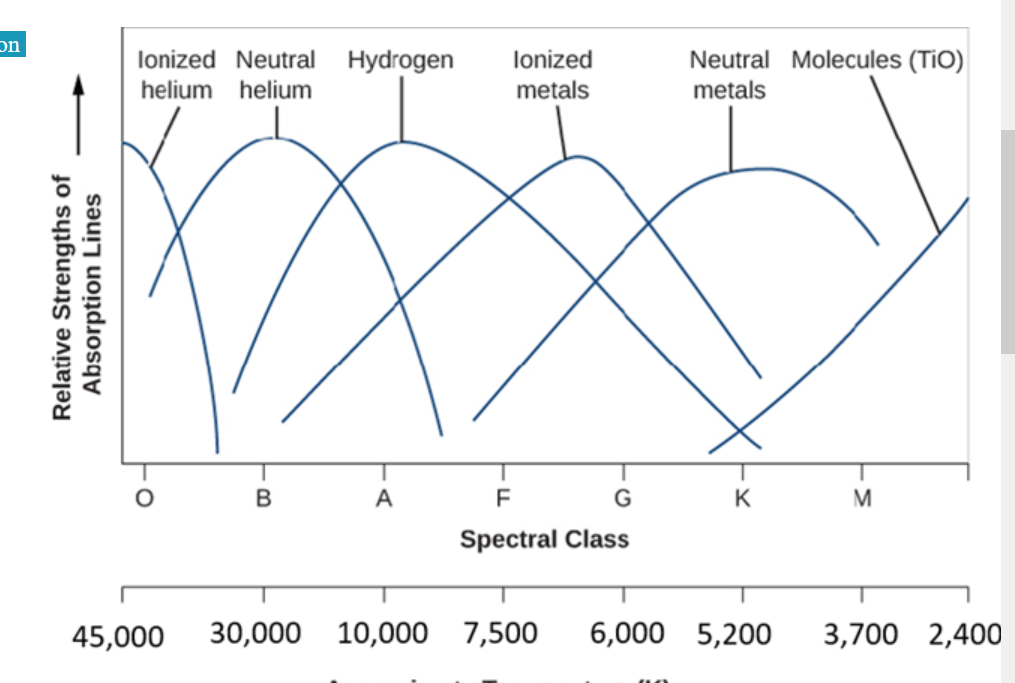
Suppose you obtained a stellar spectrum and it had weak hydrogen absorption lines and comparatively strong neutral helium absorption lines.
What would be a reasonable temperature estimate for this star?
a) 6,000 K
b) 40,000 K
c) 25,000 K
d) 10,000 K
c
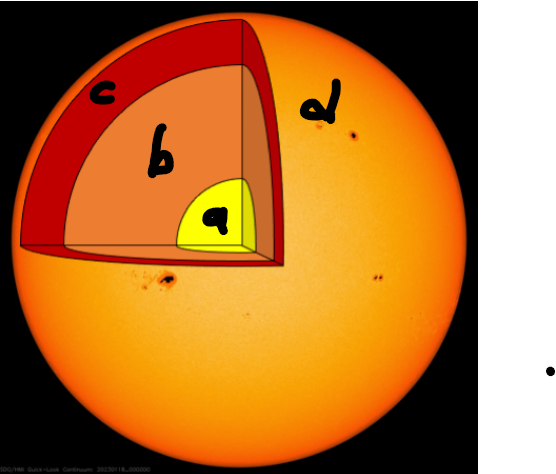
The image shown here illustrates the Sun and its internal structure.
Which region of the Sun where it generates energy via nuclear fusion?
a
Note: Some words are missing from the following paragraph.
Spectra are like the barcodes used at the supermarket checkout; each pattern can be scanned to provide information about the star. The main reason spectra of different stars are different is that the stars have different surface __________. While we know that each _________ leaves a different pattern in the spectrum, mostly the stars have roughly similar ___________, with only a few exceptions. The most common element in all stars is _____________. Astronomers use the patterns in the spectra of stars to sort all stars into categories called ___________; the hottest stars are given the letter . Objects which are not hot enough for hydrogen fusion to take place in their cores are called _________.
Word bank: A, M, hydrogen, cannon characteristics, carbon, element, diameters, spectral types, Gilese objects, temperatures, compositions, luminosities, magnitudes, planetoids, silicon, brown dwarfs, K, O
temperatures, element, compositions, hydrogen, spectral types, O, brown dwarfs
What do the two axes of the HR diagram represent?
X axis - Temperature from Hot to Cool
Y axis - Luminosity from Faint to Bright
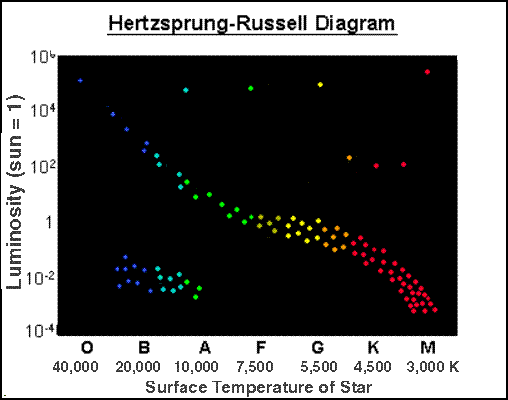
Where is the main sequence of this HR diagram?
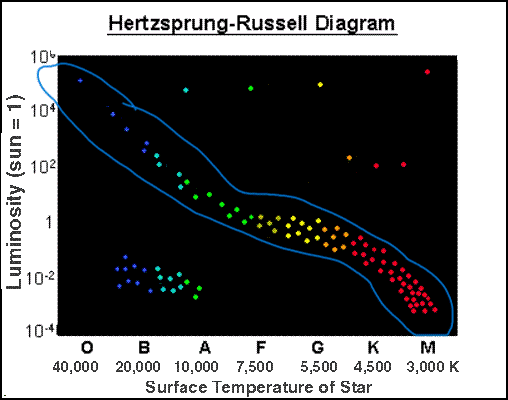
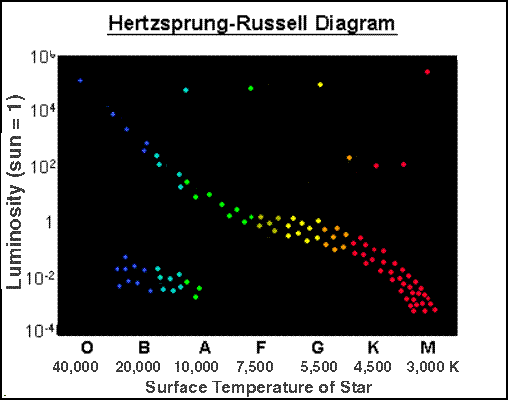
Where are the white dwarfs of this HR diagram?

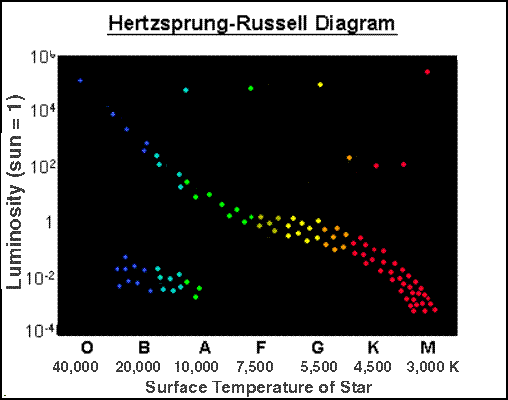
Where are the red giants of this HR diagram?
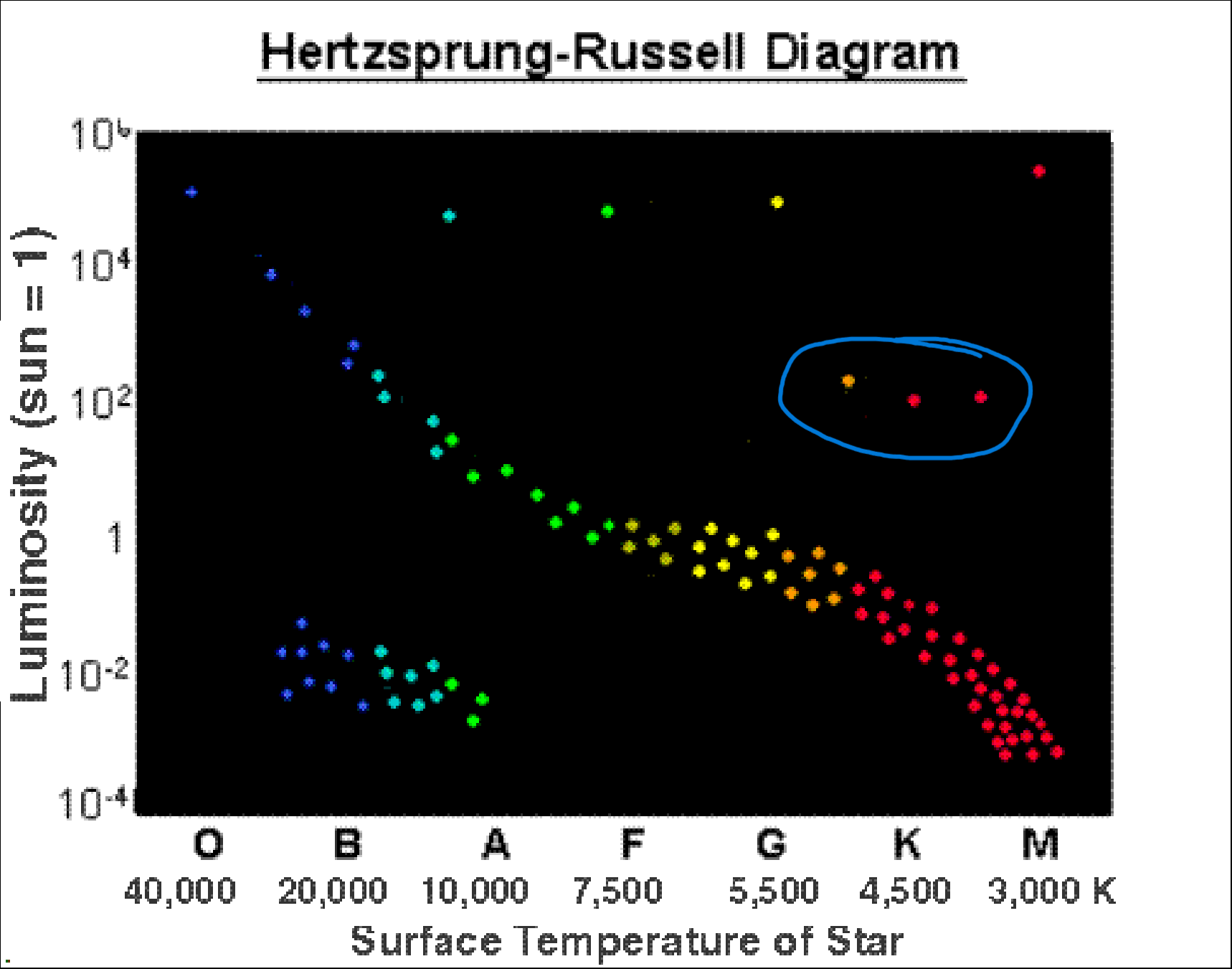
What does the main sequence turn-off point mean in a HR diagram
In a open/globular cluster, all stars are the same age so the main sequence turn off point is the “age” of this cluster of stars
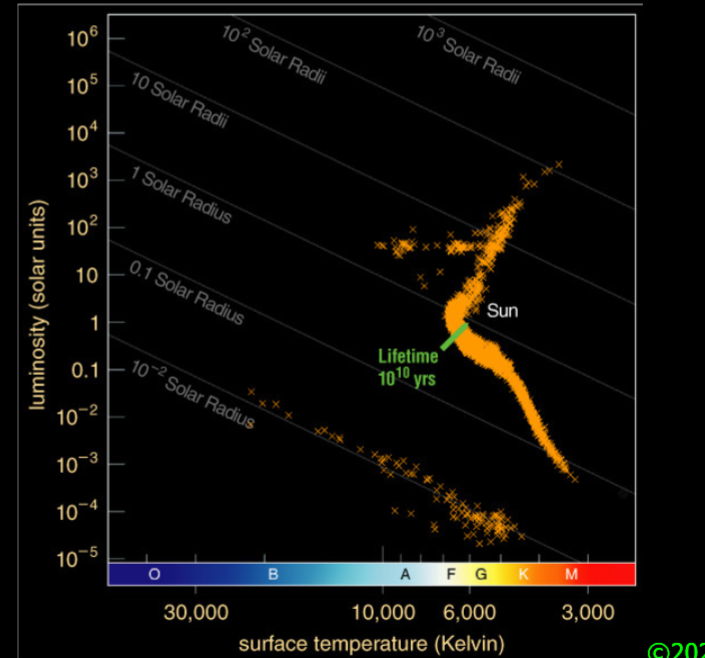
What is the horizontal branch on an HR diagram
a phase of stellar evolution undergone by intermediate-mass stars, i.e. those with masses 0.8 M⊙ < M < 8 M⊙, a range which encompasses the majority of stars in the Galaxy, including our Sun. After departing the Main Sequence, these stars spend time on the Red Giant Branch, then undergo the triple alpha process ( I am not sure the scope we need to understand this because to my knowledge we have not gone over this in class)
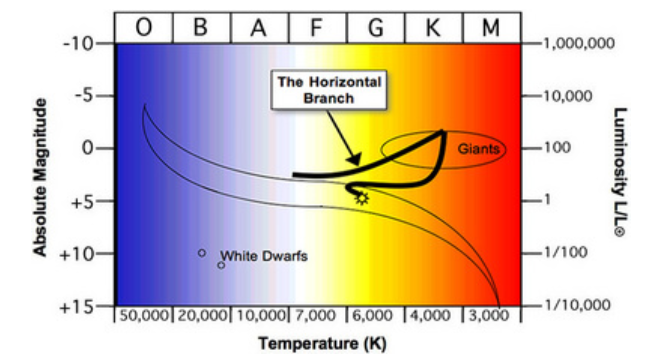
What characteristic do all stars on the main sequence have?
All stars on the main sequence have hydrogen fusion happening in their cores.
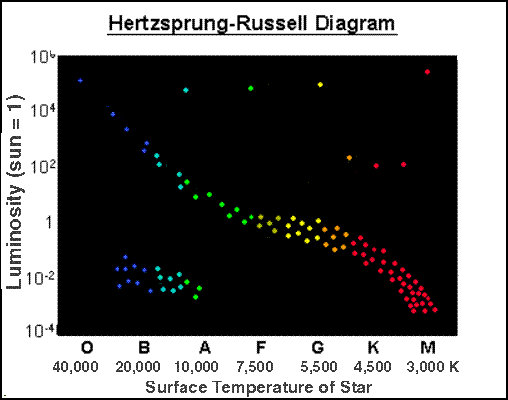
Where are the masses larger, on the upper left or bottom right of the main sequence?
upper left
How do the luminosity and temperature of a main sequence star depend on its mass?
As luminosity and temperature increase, the mass increases.
Why does the luminosity of a main sequence star depend on its mass? (hint: what happens in the core?)
A larger mass means that the pressure at the center of the star is larger (this means larger temperatures and densities) therefore the fusion rate goes up, which means higher luminosity
Imagine two main sequence stars where the mass of Star A is larger than Star B, which star do you think has a shorter lifetime?
Star A
Why are star clusters important in understanding how stars evolve?
Since star clusters are all around the same time, we can look at the length of the star clusters main sequence to determine how old it is.
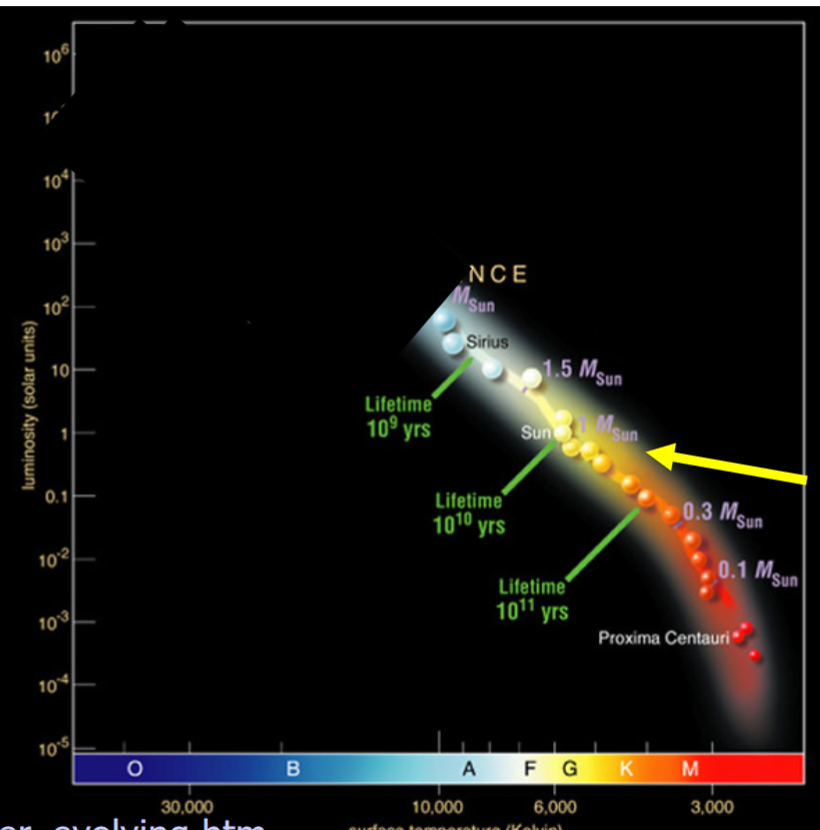
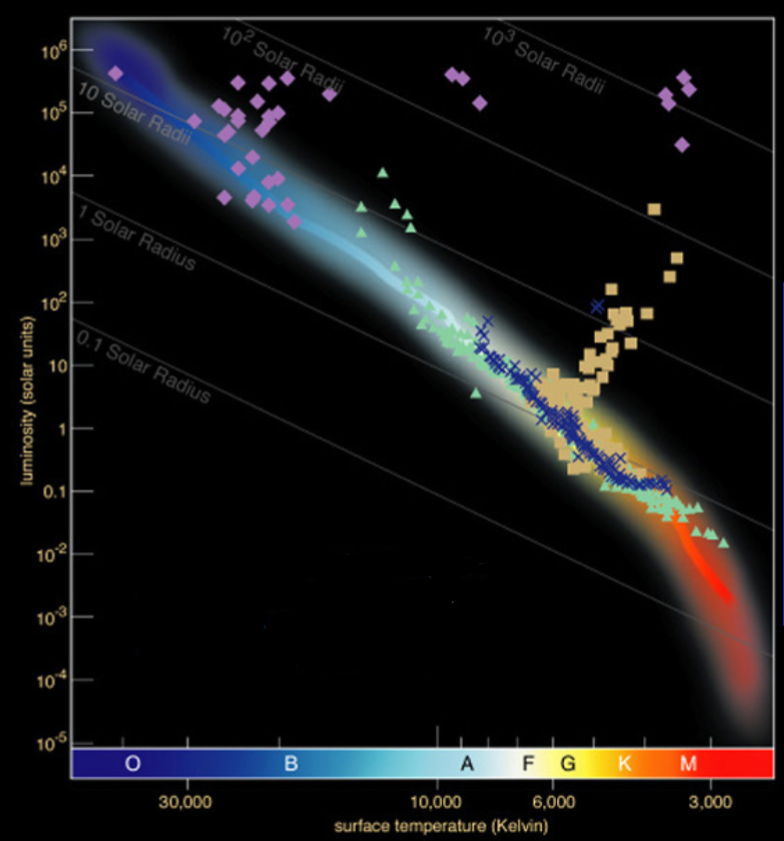
Rank the different colors in terms of age from youngest to oldest (these are star clusters)
purple, green, blue, orange
What is happening in the center (core and any shells) the outer layers of low mass stars in the Red giant Phase?
Hydrogen shell fusion. The core has become Helium, and the core is doing Hydrogen Fusion.
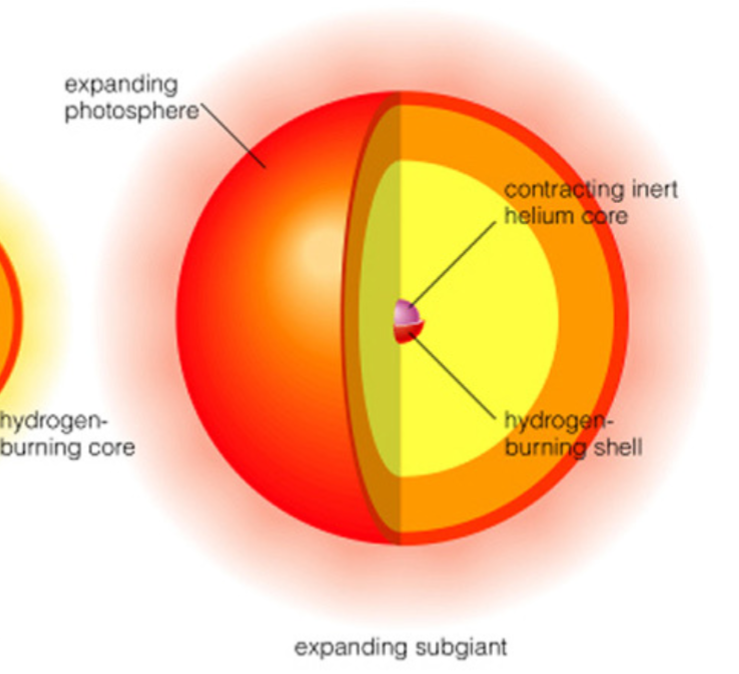
What is happening in the center (core and any shells) the outer layers of low mass stars in the Hydrogen Burning Phase?
At the core: Helium is being fused into Carbon at the core, and in the shell there is Hydrogen fusion
In the outer layers: Star shrinks and becomes slightly less luminous, but the surface temperature increases, moves to Horizontal Branch
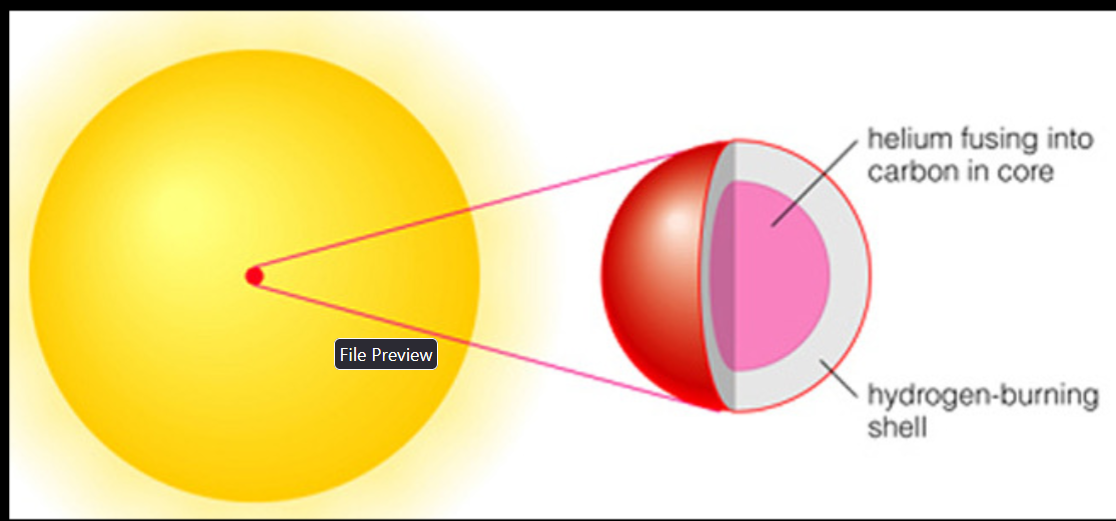
What is happening in the center (core and any shells) the outer layers of low mass stars in the Asymptotic Giant Branch Phase?
At the core: Runs out of helium, core collapses leaving carbon ash
At the shell: Shell becomes how enough to fuse helium into carbon
Outer layers: Shell outside that continues fusing Hydrogen to Helium
Star produces huge luminosity
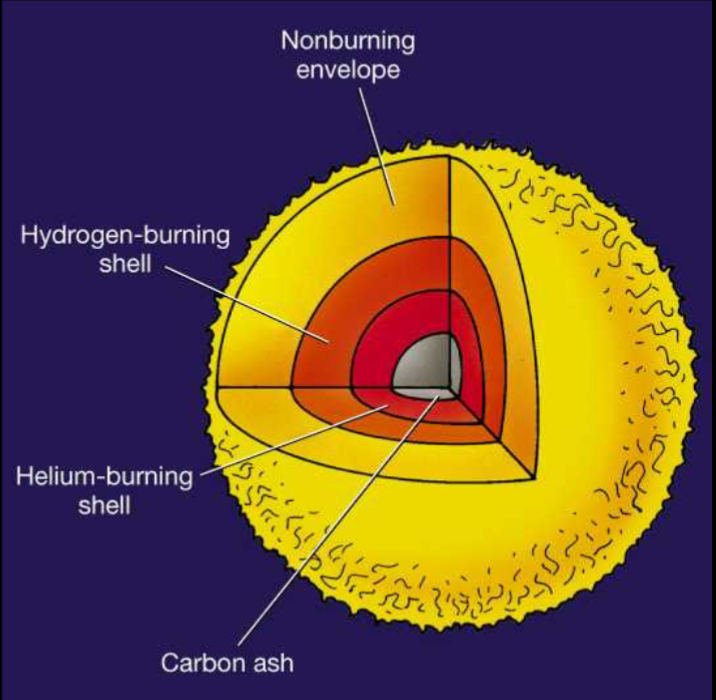
What causes stellar cores to collapse at the end of their main sequence lifetime?
Remember Hydro-static Equilibrium.
Stars stay the same size because of the balance of thermal energy pushing out and gravity pushing in. When the cores stop burning, there is no longer thermal energy and it cools down, which allows for the gravitational pressure to collapse the core.
What happens after stars run out of hydrogen in their cores?
If they are small (0.8 M to 8 M where M is the mass of the sun)
Core starts to shrink when no more hydrogen to burn leads to higher heat
Higher heat allows for the shell above the core to start fusing the remaining Hydrogen
Pressure from the shell pushes everything around it outwards (leading to it getting bigger , red giant), Core is collapsing
What is happening during the planetary nebula phase of a low-mass star's life (what is a planetary nebula, and how does it change with time?)
Right before becoming a planetary nebula: Thermal pulses from helium shell burning is unstable, pulsation pushes outer layers of star away, becomes gas in the galaxy called a stellar wind.
Planetary nebulae expand with time, gas expands into universe, leaving behind a white dwarf.
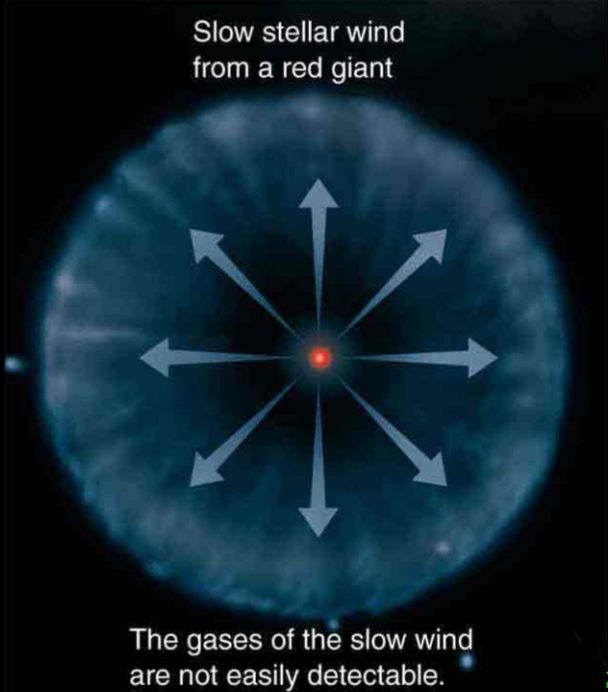
Be able to draw the "life track" of a low-mass star on the HR diagram
